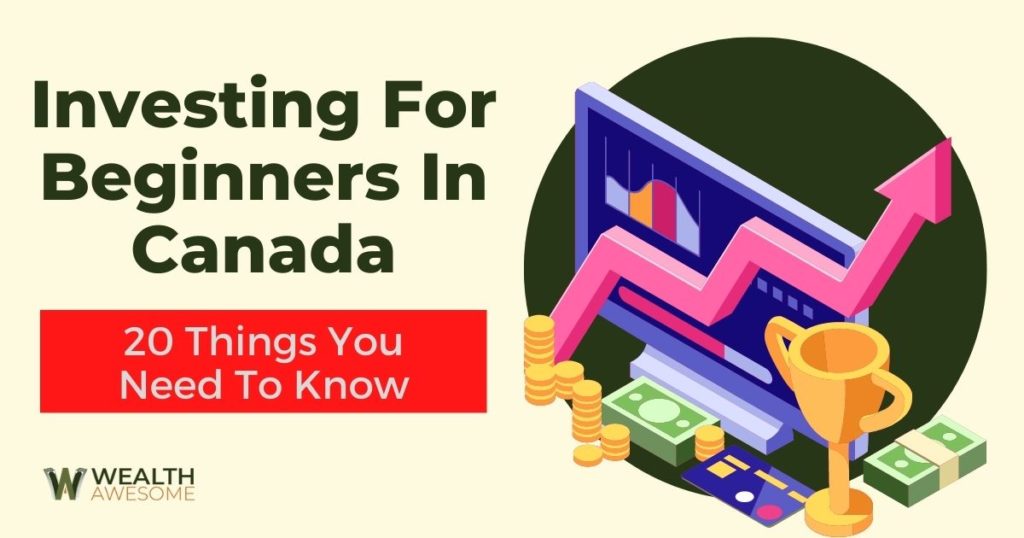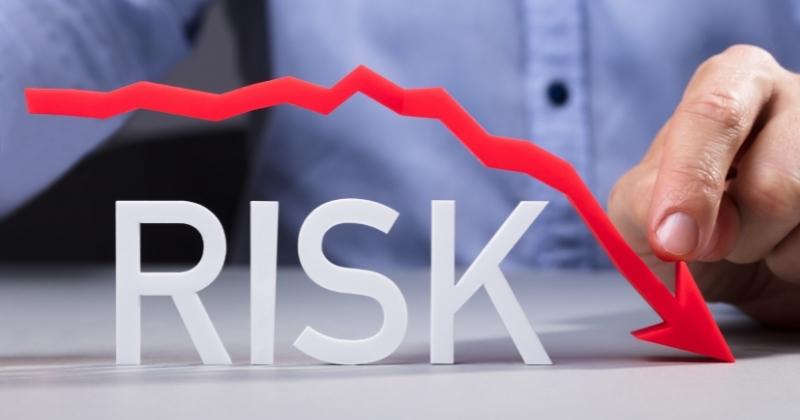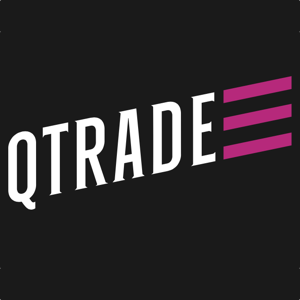Are you interested in becoming an investor to put your money to work for you but don’t know how to begin?
If you are a complete beginner at investing, understanding where or even how to begin investing can be overwhelming.
As an investor, the more you learn about investing, the more you will realize that there is so much else to learn. However, even the most experienced and successful investors start as beginners.
I have worked for over a decade in the finance industry in Canada, and I find myself learning new things about investing each day.
I have created this guide on investing for beginners in Canada to tell you what you need to know so that you can start your journey towards financial freedom as an investor in Canada.

1. What Is Investing?
Investing is essentially the practice of spending your money to make more money and achieve your financial goals. It is a pretty concise definition that makes investing seem simple on the surface.
Investing involves using the money you have and committing it to something that can provide you with returns and earn more money.
Many people are already aware of the concept of saving money being a way to build your wealth.
Investing is different from merely setting aside money and watching it grow gradually as you keep setting aside more money over time.
Investing entails more risk than saving money because saving money is virtually guaranteed to help you grow your wealth. When you invest your money in something, you might not always get the returns you seek.
However, the higher risk also comes with greater rewards. Suppose you find the right investments to allocate your funds to. In that case, the returns you get through investing can be far greater for your long-term financial goals than setting money aside.
If you were to simply put some money under the mattress, you would never have more money than what you put away yourself. Investing gives you the opportunity to use your savings to end up with far more money than you initially put aside.
2. Why Should I Start Investing?

If saving money by setting some aside and accumulating it can help you build your wealth without any risk is possible, you might be wondering what is the point of investing it at all.
Besides achieving financial freedom to meet your life goals, like a comfortable retirement or an amazing house, there is a more important reason you should not be satisfied with just setting money aside: Inflation.
Inflation is causing the cost of living to rise over time. The annual inflation rate in Canada in March 2021 was 2.2%. So if you store some money safely for a few decades, it will lose value over time. The same amount of money will afford you far less, just 20 or 30 years down the line.
When you invest your money instead of stashing it somewhere it does not grow, the returns from your investment can grow your wealth and help you keep up with or even beat inflation rates.
Common Investment Terms You Should Know
Getting started on the right foot as a beginner in the investment world means understanding some of the basic concepts. This section of my guide on investing for beginners in Canada will take you through common investment terms that you should understand before you can even dip your feet in the water.
3. Risk

Risk is a key factor for any investment you make. The term describes the potential of losing your money when you invest it, or it can be used to describe the level of uncertainty about what you will earn or lose on your investment.
There are varying levels of risks involved when you invest your money, but almost every type of investment entails some risk. Traditionally, the higher the potential return from an investment, the higher the risk.
4. Return On Investment

Return On Investment, or ROI, describes the growth of the money that you invested or the profit you earn from putting your money to work. The ROI can be vastly different, depending on what you invest in, how you get the returns and the risk that your investments entail.
With some low-risk investments, it is possible to determine your ROI before investing the money. For other investment types, it is impossible to predict your ROI with certainty.
Returns on your investments can come in two forms:
- As Income: The money you invested provides you with consistent returns through interest or dividends. Dividends are a portion of a company’s profits that it pays to its shareholders or ‘investors’ as a reward for investing their money in the business.
- As Increased Value: Also called ‘capital gain,’ this return on your investment is through the growing value of your investment. You can sell your investment at a higher price to capture the profits through capital gains.
‘Capital loss’ is the term used to describe a negative ROI. This happens if your investment loses value.
5. Capital

Capital is a broad term that can be used to describe anything that covers value or benefit to its owner. Within the context of investing, the money that you have can be considered as capital, but it is more often associated with money that you are putting to work through investments.
6. Risk Tolerance

Risk tolerance is used to describe how comfortable you are with the uncertainty of not knowing what you will earn or lose on your investment or the risk involved with your investment.
Suppose that you are willing to take very little or no risk with your investment capital. That would define you as a risk-averse investor or that you have a low-risk tolerance.
In case you are willing to stomach a higher risk with the possibility of losing some or all of your investment for the potential returns, you would be considered to have a high-risk tolerance.
Knowing your risk tolerance is crucial because it can help you find investment vehicles that suit your financial goals and willingness to risk losses. Finding out your risk tolerance can be as simple as asking yourself a few questions, including:
- When will you need the money?
- Do you have enough savings set aside to cover your expenses and debts in case you lose your investment capital?
- Do you have a steady and secure revenue stream?
- Can you avoid making emotionally driven decisions regarding investments that are volatile (investments that can have a drastic change in value) or where your returns are unpredictable?
- How would you react if you experience significant capital loss on risky investments?
My experience as a financial advisor has shown me that most people tend to overestimate their risk tolerance. As a beginner, I recommend starting with a lower risk tolerance than you think you need and gradually increasing your risk tolerance as you gain experience in the investing world.
7. Liquidity

Liquidity is used to describe how easily you can sell or cash in on your investments. A liquid asset or investment is one that you can sell quickly. An excellent example of a liquid investment is a stock or bond.
A non-liquid asset is an investment that you cannot sell quickly. A house is the perfect example of a non-liquid investment.
8. Diversification

Diversification describes a mixture of different types of assets or investments. Diversifying your capital across different types of investments can reduce your risk of capital losses.
A simple metaphor to help you understand diversification is “not putting all your eggs in one basket.”
There are two ways you can diversify your investments:
Portfolio Diversification
It means investing in a mixture of assets to reduce your overall capital risk. In case one of your investments loses its value, the relative stability of other investments can offset your losses and keep you from losing too much money.
If you only own one asset and it loses value, you risk losing all of your investment capital.
Asset Allocation
Asset allocation means having different types of asset classes in your investment portfolio. Different types of assets come with varying risk levels, and the chances of different investment types losing their value at the same time are low.
For instance, if you invest in stocks and bonds, your investments in stocks might lose value, but the stable returns from bonds can offset some of your losses.
Types Of Investments
This section of my guide on investing for beginners in Canada will describe the different types of investments you can consider. Understanding the different types of assets you can invest your money in will be critical in defining your investing strategy based on your risk tolerance and financial goals.
Canadian investors have access to a ton of options to choose from, ranging from individual stocks to mutual funds, bonds, GICs, and cryptocurrencies, among many more. Each type of investment carries a different level of risk.
I will outline some of the most important investment types you can consider to help you start on the right foot.
9. Stocks

Risk Level: Medium to high
Stocks are defined as the portions or shares of a company that is listed on a stock market for people to buy and sell. Buying shares in a company means that you essentially own a small portion of the company. The shares you purchase will grow or decrease in value based on the company’s overall value and earnings.
Most stocks today are available as common stocks. Owning common stocks in a company gives the shareholder the right to vote and elect the board members of a company. Common stocks also reflect a portion of profits distributed by the company as shareholder dividends.
The more shares you own in a company, the greater portion of ownership you have. It also reflects on how much of a share you get in the profits of the company when it distributes its shareholder dividends.
However, investing your money to buy shares of just one company is risky because there is a chance that the company can lose money or go out of business. Diversifying your investment capital to buy shares of multiple companies reduces your capital risk.
The risk depends on the business itself as well. Shares of a well-established and profitable business carry a lower risk to own than a small start-up that has yet to become profitable. Stocks are typically considered a medium- to high-risk asset class.
How Can A Beginner Invest In Stocks In Canada?
If you want to leverage the power of owning stocks to bolster your finances and grow your wealth, knowing how to invest in stocks in Canada is the first step.
There are four primary ways in which a beginner can invest in stocks in Canada:
- Trading Platforms: Also called discount brokers, trading platforms like Questrade and Wealthsimple Trade allow you to buy and sell stocks by opening a brokerage account and buying and selling stocks on the stock market yourself. Buying stocks through trading platforms is ideal for investors who have built a good understanding of how stock markets work.
- Financial Advisor: Financial advisors are expert professionals in the financial industry who advise you on how to invest your money and manage your investments. While you can buy stocks through financial advisors, I would recommend against it because the cost of using their services is too high. With robo-advisors doing the same thing, you can get similar results at a fraction of the cost.
- Dividend Re-Investment Plans or Direct Stock Purchase Plan: You can purchase stocks directly from a company issuing stocks without using a brokerage through a DRIP or DSPP. This method of buying stocks is riskier because it requires putting a lot of faith in a company that you are investing in, and you should do this only when you are certain that the company has the potential to be profitable for years to come.
10. Index Funds

Risk Level: Low to high
Index funds are mutual fund products that hold all the stocks in a particular stock market index. For instance, an index fund tracking the performance of the S&P 500 Index will hold all 500 stocks in the proportion to their size on the index and track their performance.
The index fund’s management tries to emulate the performance of the underlying index. Your ROI through investing in an index fund will reflect the growth or decline of the index itself, minus the management fee charged by the index’s fund manager.
Index funds can track a wide range of assets across several markets worldwide. You can even buy bond index funds that hold government and corporate bonds to track their performance.
The risk level of index funds can vary drastically, depending on the index fund you choose. An index fund that invests entirely in stocks will carry greater capital risk than one that balances stocks with fixed-income securities, like bonds and GICs.
11. ETFs

Risk Level: Low to high
An Exchange-Traded Fund, or ETF, is an investment fund that lets you gain exposure to a basket of individual securities in one purchase. ETFs can also track stock market indexes like S&P 500, bonds, or a variety of asset classes mixed together.
ETFs are available to trade like standard stocks on the stock market, and their price can fluctuate based on the value of their underlying holdings.
ETFs can provide you with returns on your investment through capital gains, interest, and dividends, based on the profits distributed by the underlying assets held by the fund.
ETFs offer you a low-cost solution to invest in a diversified portfolio of securities. You can buy and sell ETFs using the same methods for investing in stocks.
ETFs are like index funds because they diversify into different assets. It means that they can carry a higher degree of capital risk, depending on what the fund invests in. An ETF that focuses the entirety of its money on stocks will be inherently riskier than an ETF that invests in different asset classes.
How To Buy ETFs in Canada
The cheapest way to buy ETFs is from discount brokers. My top choices in Canada are:

- 105 commission-free ETFs to buy and sell
- Excellent customer service
- Top-notch market research tools
- Easy-to-use and stable platform

- Stock and ETF buys and sells have $0 trading fees
- Desktop and mobile trading
- Reputable fintech company
- Fractional shares available
To learn more, check out my full breakdown of the best trading platforms in Canada.
12. Mutual Funds

Risk Level: Low to high
A mutual fund is very similar to index funds and ETFs in the sense that it is an investment fund that invests in a basket of securities in a single product. The fund managers pool the money of many investors together to buy a portfolio of different securities grouped together.
Investors earn money when the assets held by the mutual fund generate dividends or interest payments from bonds.
Mutual fund managers are responsible for rebalancing the portfolio of securities held by the fund, and investors can also get returns on their investments if the fund manager sells assets that have seen significant capital gains and distribute the profits to shareholders.
Mutual funds can be actively or passively managed. Actively managed mutual funds have a fund manager making investment decisions to try and beat a benchmark.
Passively managed mutual funds are akin to index funds that focus on tracking the performance of specific market indexes rather than rebalancing the portfolio to beat benchmarks.
However, mutual funds come at a high cost to investors, and Canadians pay fees as high as 2-3%, making it a costly financial instrument. Mutual funds invest in a variety of different assets, making them less risky due to diversification.
However, a mutual fund that allocates all its resources to stocks carries greater capital risk than a more balanced fund.
13. Bonds

Risk Level: Low
Bonds are an investment type that comes with virtually zero capital risk. A bond is essentially a certificate issued by a company or government for a loan you make to the issuer. In exchange for buying the bond, the issuer promises to pay you at a predetermined interest rate and to repay the loan on a predetermined date.
Even though you are effectively giving a loan when you buy a bond, it is an investment in exchange for returns. The safest bonds are federal government bonds, provincial government, and corporate bonds. Bonds issued by companies at a higher risk are considered junk bonds.
Bonds are considered an essential part of any investment portfolio because they represent a safer asset class than stocks or other investment types.
People who are heavily invested in the stock market and want to add a degree of defensiveness to their investment portfolios can consider diversifying their portfolios by buying bonds.
You can also purchase mutual fund products or ETFs that focus on bonds if you want exposure to a basket of bonds in a single product. Since bonds carry lower capital risk, you should also expect lower returns.
As a bondholder, you are not buying shares of a company – you are a lender. You should expect to receive returns through interest payments, plus the return of your initial investment when the bond matures. Interest rate changes are inversely proportional to bond prices bonds.
Bond prices tend to fall when interest rates rise and decline when interest rates are low. Long-term bonds are more susceptible to rate movements than short-term bonds.
14. GICs

Risk Level: Very low
A Guaranteed Income Certificate (GIC) is another investment type that carries low capital risk. It is an investment that pays you at a guaranteed interest rate, and it is considered to be the safest form of investment.
Of course, that comes with the prerequisite that you can also expect the lowest returns on your investment when you buy GICs.
GICs pay you interest at a fixed annual interest rate for a set fixed duration, with terms lasting one to five years. While most investment types carry a varying degree of at least some risk, you cannot lose any of your investment capital allocated to buying GICs.
15. Cryptocurrency

Risk Level: Very high
Cryptocurrency is a new asset class and one that I do not generally recommend due to the unusually high capital risk that comes with it. Cryptocurrencies are digital currencies that are not regulated by any central bank or regulatory body.
They are also called decentralized currencies because their management depends on the people who buy and use them.
Cryptocurrency trading has become immensely popular in recent years with the rise of several cryptocurrencies over the years. Many people have started investing in them as an alternative to traditional asset classes.
You can buy and sell cryptocurrencies through cryptocurrency exchanges like Wealthsimple Crypto that are making it easier for investors to trade the new asset class.
Regulated ETFs like Canada’s first Bitcoin ETF make it even easier for you to invest in cryptocurrencies without the typical challenges that come with investing through cryptocurrency exchanges.
The cryptocurrency world is mostly unregulated and highly volatile. There is no way to determine how the price movements take place.
The value of cryptocurrencies does not depend on any fundamentals that can help you identify good or bad investments in traditional asset classes like stocks and bonds. A cryptocurrency’s value depends on individual supply and demand.
The extreme intraday price changes make cryptocurrencies a very high-risk investment to consider. If you have the stomach to risk losing all the money you invest in an asset, you can try to invest in cryptocurrencies.
However, I would recommend only investing what you are willing to lose if you dabble with cryptocurrencies.
16. Determining Your Asset Allocation

Knowing your risk tolerance and understanding the different types of assets and the capital risk they entail can help you shape up your investment portfolio. I will specifically discuss how to diversify your investment capital into investing in stocks and bonds (and other fixed-income securities).
For the purpose of this guide, I will not consider cryptocurrencies as an asset class you should diversify into.
There are three basic types of asset allocations that you can go for in your investment portfolio:
Low Risk
A low-risk portfolio typically has an asset allocation split of 40% towards stocks and 60% towards bonds and other fixed-income securities.
Medium Risk
A medium-risk portfolio typically has an asset allocation split of 60% towards stocks and 40% towards bonds and other fixed-income securities.
High Risk
A high-risk portfolio might see you allocate as much as 100% of your investment capital in stocks or with very little exposure to bonds and other fixed-income securities.
When you are creating and rebalancing your investment portfolio, you should always remember that diversification can be critical to help you meet your financial goals while reducing capital risk.
Diversifying into different asset classes and assets from different industries will help you make a more sustainable portfolio that can provide you with a hedge against volatility in the economy.
Choosing An Investment Vehicle
The final thing to know is that you can invest using different types of accounts.
This section of my guide on investing for beginners in Canada will discuss the different account types that you can use to create your investment portfolio in so that you can make the most of your return on investment based on your financial goals.
Canadians have access to taxable (non-registered) and non-taxable (registered) accounts. Ideally, you should focus on using the available contribution room in your registered accounts for the tax benefits they offer before you start using a non-registered investment account.
17. Registered Retirement Savings Plan

A Registered Retirement Savings Plan, or RRSP, is a type of retirement savings plan that lets you enjoy tax-deferred growth for your savings in the account.
You can use the account as a simple saving account to store cash, but the account can also hold a wide range of investments like stocks, bonds, mutual funds, ETFs, GICs, and more.
There is an annual limit to how much you can invest in your RRSP set at 18% of your gross income or $27,830 for 2021, whichever is lower.
For any contributions you make to your RRSP, you can receive a tax deduction for that amount. You get the benefit of reducing your taxable income for that year. You should know that an RRSP offers tax-deferred growth. It means that you will have to pay taxes on any withdrawals you make from the account.
18. Tax-Free Savings Account

A Tax-Free Savings Account, or TFSA, is a registered account that offers you tax benefits. The contributions you make to a TFSA are made in after-tax dollars. It means that any returns that you get from your investments stored in a TFSA can grow tax-free.
You do not have to pay any taxes on your income in a TFSA. You can use the account to store most financial instruments like bonds, stocks, GICs, mutual funds, and more.
The TFSA comes with an annual contribution limit. For 2021, the annual contribution limit was $6,000. If you were 18 years or older in 2009 and were eligible to invest in a TFSA, your cumulative contribution is $75,500.
19. Registered Education Savings Plan

A Registered Education Savings Plan, or RESP, is a registered and tax-sheltered investment account designed specifically for people who want to save for their child’s post-secondary education or training.
While you do not get any tax deductions on contributions to an RESP, you also do not have to pay income tax on earnings in your account.
The Canadian government provides a 20% Canadian Education Savings Grant (CESG) on annual RESP contributions for up to $500 each year and $7,200 in total for each child, making it an ideal investment vehicle for Canadian parents who want to be able to set aside significant funds for their children’s education.
20. Non-Registered Investment Account

Non-registered accounts are also called taxable accounts, cash accounts, margin accounts, or trading accounts, depending on the investment platform you use. Regardless of which non-registered account you use, you should know that there are no tax benefits for investments you hold inside the account.
It means that any income through dividends or interests entails income tax each year. Any capital gains you get by selling investments held in your account for a profit will make you liable to pay capital gains tax.
Conclusion
I know and understand that learning how to start investing, even with a comprehensive guide like this one, is not simple. It is a long process that involves a lot of learning, and you will face challenges on your way to becoming a successful investor.
You will probably make mistakes along the way, but let me tell you that you should not let a few bad investments keep you from going for it.
I, for one, made many mistakes when I started. Having a guide on investing for beginners in Canada when I started would have definitely helped me. I have used all my good and bad experiences to teach me, and I have gotten better at it over the years.
We all start somewhere, and I hope my guide can help you start investing on the right foot. If you want to learn how to save money so that you can build the investment capital you need to get a strong start, check out my guide on how to save money in Canada.



`I live in USA. So am I eligible to open a Canadian brokerage account and purchase financial goods? (ETF’s, bonds etc.)
No I don’t think you are. But you should have plenty of access to Canadian stocks through most U.S brokers